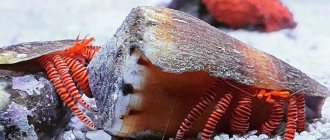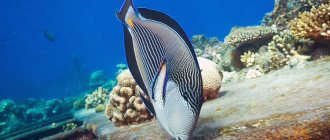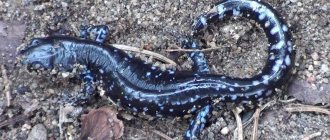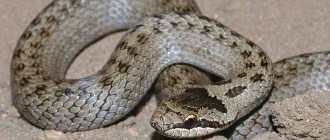Our planet is home to a huge variety of animals, so many of us are not even aware of the existence of some of them. Did you know that there are creatures in the world that look like slippery worms and poisonous snakes at the same time? They are called caecilians (Caeciliidae) and live in the soils of tropical regions of Africa, Asia and America. Since they lead an underground lifestyle, scientists know very little about them, but research work is constantly being carried out. For example, recently biologists from Brazil managed to find out that the caecilian’s mouth contains many poisonous teeth. There is an assumption that these creatures are the only amphibians that secrete poison not only with their skin, but with their teeth. So what is it that if you dig up these creatures and touch them, the person will die?
Worms look pretty weird, don't they?
Features of the structure of caecilians
These amphibians are very similar in appearance to large worms. Thanks to the numerous ring-shaped interceptions of the body, the resemblance to a worm only intensifies. The small head of the caecilian smoothly transitions into a long body, which has neither a tail nor legs. Moreover, even the cloaca of the caecilian is located on the posterior pole of the body.
The size of this amphibian very rarely exceeds 45 cm. An exceptional example is the Thompson's caecilian, which lives in the Colombian mountains. The length of her body reaches 120 cm.
Worms (lat. Caeciliidae)
Under the skin of amphibians of this species there are hidden scales, inherited from their distant armored ancestors.
On the remains of the notochord there are vertebrae like those of fish. By the way, their number is very large - from 200 to 300 pieces. Despite the primitive structure of the heart (a single atrium is divided by an incomplete septum and there is only one ventricle), the structure of the forebrain suggests that caecilians are much better developed than other amphibians.
Since this amphibian spends most of its life underground, the eyes of caecilians are not developed. They are hidden under the subcutaneous tissue or grown into the bone and do not function at all.
The caecilian has no eyes.
Caecilians also cannot boast of hearing acuity. They do not have an auditory canal or eardrum, and the inner ear is completely unconnected with the external environment. Caecilians can only detect loud sound, which has a frequency of 100 to 1500 hertz. But the sense of smell in these amphibians is very highly developed.
Evolution and lifestyle
The word caecilian comes from the Latin caecus, meaning “blind.” This was the name of the first species of caecilians described by Carl Linnaeus, who designated them as Caecilia tentaculata. The most recent classification from 2011 divided caecilians into 9 families containing almost 200 species.
Little is known about the evolutionary history of caecilians, which have left few fossils. The earliest fossil comes from the Jurassic period. This primitive genus Eocaecilia had small limbs and well-developed eyes. In their description of the batrachian fossil Gerobatrachus, the researchers suggested that caecilians evolved from the thin-vertebral groups of an ancestral tetrapod, and therefore may be more closely related to amniotes than to frogs and salamanders.
https://youtube.com/watch?v=ETFPjXFq1sk
Behavior and reproduction
There is little information about the behavior of terrestrial caecilians due to their secretive activity in the soil. Some species are known to emerge from deep soil or leaf litter at dusk or dawn, often during light rain. Caecilians spend most of their time in their burrows , but are also capable of movement. Little is known about aquatic caecilians either, as they typically live in slow-moving rivers and streams with a lot of organic material in the water, making observation difficult.
Caecilians are the only amphibians that use internal insemination. Male caecilians have a long tubular organ, the phallodeum, which is inserted into the female's cloaca. About 25% of caecilian species are oviparous, the remaining 75% are viviparous. The fetus feeds inside the female on the cells lining the oviduct, gnawing them with special scraping teeth.
Eating caecilians
The diet of caecilians is still poorly understood. Adults are thought to feed primarily on insects and other invertebrates found in the habitat of the respective species. But the stomach contents of 14 specimens of the gigantic caecilian consisted mainly of unidentifiable organic material and plant debris. The identifiable remains discovered were found to be termite heads.
Caecilians wait for prey, remaining in burrows or on the surface of the substrate. They rush at their prey, grabbing it with strong jaws, and gradually swallow it. Their diet includes:
- earthworms;
- termites;
- small invertebrates;
- small lizards, snakes and rodents.
Caecilians are mysterious creatures that have not yet been fully studied. But what is already known about them once again convinces everyone of the unusual nature of these creatures.
Eating caecilians
The diet of these burrowing amphibians includes blind snakes, earthworms, shield-tailed snakes, soil insects and mollusks.
The caecilian feeds on smaller classmates and insects.
For some annelids, the main food is termites and ants. Amphibians of this species are very well adapted for life in the ground. With the help of a small, firmly built, dense head, the animal easily makes its way .
This is facilitated by a long body with intercepted rings, as well as an abundance of mucus. Moreover, the mucus of many amphibians is poisonous. It is secreted with the help of numerous skin glands, which are concentrated in each ring of the anterior section. Thanks to this feature, snakes do not touch caecilians; termites and ants are afraid of them.
Ringed caecilians
These legless creatures live exclusively in South America, in areas east of the Andes. They are found in Brazil, Argentina, Venezuela, Suriname, Paraguay, Peru and Ecuador.
These creatures are not famous for their large sizes and reach a length of only 40-50 centimeters. The body of annelid caecilians is noticeably divided by transverse rings. Their larvae are equipped with 44 small teeth, with which they eat the top layer of the mother's skin. After eating everything in a matter of minutes, they wait about three days for the skin to grow back. The phenomenon is called “maternal dermatophagy” and it lasts until the babies grow up and are able to feed on their own.
Reproduction
The process of reproduction of amphibians has not yet been fully studied. These amphibians lay eggs in damp soil.
After 6 months, which is how long the pregnancy of a female caecilian lasts, small caecilians are born, the number of which can reach up to 7 individuals. The body of the cubs does not exceed 10 cm, and in appearance they are small copies of their parents.
Baby caecilians hatching from eggs.
The food for newborns is gill sacs, which the female bites off for her babies. From the very first day of birth, little worms feed independently.
Worms that lay eggs take no less amazing care of their offspring. Moreover, they do not require a river or lake to reproduce, because the caecilian’s own mucus serves as moisturizer for the eggs. It is also known that some of them (four species in total) feed their own skin to their young.
If you find an error, please select a piece of text and press Ctrl+Enter.
Habitats
Terrestrial caecilians live in areas with loose, moist, organically rich soil and leaf litter. Some individuals are often found under stones and branches, others - near streams and on river banks.
Caecilians are found in humid tropical areas:
- South-East Asia;
- India;
- Bangladesh;
- Nepal;
- Sri Lanka;
- East and West Africa;
- Seychelles and Indian Ocean;
- Central America and northern and eastern South America.
Some species are also found in Southern China and Northern Vietnam. In Southeast Asia they can be seen in Java, Borneo, the southern Philippines, but the range does not cross the Wallace Line and is not present in Australia or nearby islands.
https://youtube.com/watch?v=hO3eOBUp6MQ
Notes
- Ananyeva et al., 1988, p. 12.
- ↑ 123
Amphibian Species of the World 6.0, an Online Reference: Gymnophiona Müller, 1832. American Museum of Natural History, New York, USA. Retrieved February 13, 2015. - Gymnophiona (English) information on the Paleobiology Database website. (Accessed May 14, 2020).
- Latreille PA
Familles naturelles du règne animal: exposées succinctement et dans un ordre analytique, avec lindication de leurs genres. - Baillière, 1825. - P. 103. - 590 p. - Gymnophiona (English). Amphibians of the World 6.0, an Online Reference
. Date accessed: May 24, 2021. - ↑ 12
Exbrayat, 2006, p. 2. - Exbrayat, 2006, p. 3.
- ↑ 1 2 3 4 5 William E. Duellman.
Gymnophiona (English).
Encyclopædia Britannica
. Encyclopedia Britannica (20 February 2015). Date accessed: May 24, 2021. - Skeleton of amphibians (undefined)
.
Foxford
. foxford.ru. Date accessed: May 21, 2021. - V. N. Tonkov.
Textbook of normal human anatomy. — Ripol Classic, 2013-04. — P. 550. — 783 p. — ISBN 978-5-458-63286-7. - M. S. Gilyarov.
Biological encyclopedic dictionary. - Ripol Classic, 1989. - P. 320. - 895 p. — ISBN 978-5-458-25596-7. - ↑ 1 2 Rastogi RK
Reproductive Biology and Phylogeny of Gymnophiona (Caecilians). Jean-Marie Exbrayat, editor. (English) // Integrative and Comparative Biology. — 2007. — June 1 (vol. 47, no. 5). - P. 789-790. — ISSN 1540-7063. - doi:10.1093/icb/icm009. [] - Review of amphibian orders: Legless (undefined)
. biocpm.ru. Date accessed: May 21, 2021. - Igor Shilov.
Organism and environment. Physiological ecology. Textbook for universities. — Litres, 2020-02-09. - P. 61. - 181 p. — ISBN 978-5-04-232245-7. - Wake Marvalee H.
Fetal adaptations for viviparity in amphibians (English) // Journal of Morphology. — 2014. — March 19 (vol. 276, no. 8). — P. 941—960. — ISSN 0362-2525. - doi:10.1002/jmor.20271. [] - Exbrayat, 2006, p. 18.
- Jenkins Parish A., Walsh Denis M.
An Early Jurassic caecilian with limbs (English) // Nature. - 1993. - September (vol. 365, no. 6443). - P. 246-250. — ISSN 0028-0836. - doi:10.1038/365246a0. [] - Anderson JS, Reisz RR, Scott D., Fröbisch NB, Sumida SS
A stem batrachian from the Early Permian of Texas and the origin of frogs and salamanders. (English) // Nature. - 2008. - May 22 (vol. 453, no. 7194). - P. 515-518. - doi:10.1038/nature06865. — PMID 18497824. [] - Huttenlocker Adam K., Pardo Jason D., Small Bryan J., Anderson Jason S.
Cranial morphology of recumbirostrans (Lepospondyli) from the Permian of Kansas and Nebraska, and early morphological evolution inferred by micro-computed tomography (English) // Journal of Vertebrate Paleontology. — 2013. — May (vol. 33, no. 3). — P. 540—552. — ISSN 0272-4634. - doi:10.1080/02724634.2013.728998. [] - San Mauro Diego.
A multilocus timescale for the origin of extant amphibians // Molecular Phylogenetics and Evolution. - 2010. - August (vol. 56, no. 2). — P. 554—561. — ISSN 1055-7903. - doi:10.1016/j.ympev.2010.04.019. [] - ↑ 1 2 3 Pardo Jason D., Small Bryan J., Huttenlocker Adam K.
Stem caecilian from the Triassic of Colorado sheds light on the origins of Lissamphibia (English) // Proceedings of the National Academy of Sciences. — 2021. — June 19 (vol. 114, no. 27). — P. E5389—E5395. — ISSN 0027-8424. - doi:10.1073/pnas.1706752114. [] - Wilkinson, M.; San Mauro, D.; Sherratt, E.; Gower, D. J. (2011). A nine-family classification of caecilians (Amphibia: Gymnophiona). Zootaxa 2874
: 41–64. - Kamei, R. G.; San Mauro, D.; Gower, D. J.; Van Bocxlaer, I.; Sherratt, E.; Thomas, A.; Babu, S.; Bossuyt, F.; Wilkinson, M.; Biju, S. D. (2012). "Discovery of a new family of amphibians from Northeast India with ancient links to Africa". Proc.
R. Soc. B. doi:10.1098/rspb.2012.0150. - "New amphibian family find for India". BBC News. February 22, 2012.
- "New amphibian family found in India". CBC News. 21 February 2012.
- Eocaecilia
(English) information on the Paleobiology Database website. (Accessed May 1, 2017). - Rubricacaecilia
(English) information on the Paleobiology Database website. (Accessed May 1, 2017). - San Mauro Diego, Gower David J., Müller Hendrik, Loader Simon P., Zardoya Rafael, Nussbaum Ronald A., Wilkinson Mark.
Life-history evolution and mitogenomic phylogeny of caecilian amphibians (English) // Molecular Phylogenetics and Evolution. — 2014. — April (vol. 73). - P. 177-189. — ISSN 1055-7903. - doi:10.1016/j.ympev.2014.01.009. [] - Gutierre Robson Campos, Jared Carlos, Antoniazzi Marta Maria, Coppi Antonio Augusto, Egami Mizue Imoto.
Melanomacrophage functions in the liver of the caecilian Siphonops annulatus (English) // Journal of Anatomy. — 2021. — 4 December (vol. 232, no. 3). - P. 497-508. — ISSN 0021-8782. - doi:10.1111/joa.12757. []
Literature
- Legless amphibians // Encyclopedic Dictionary of Brockhaus and Efron: in 86 volumes (82 volumes and 4 additional). - St. Petersburg, 1890-1907.
- Werner Himstedt: Die Blindwühlen
. — ISBN 3-89432-434-1. - Ananyeva N. B., Borkin L. Ya., Darevsky I. S., Orlov N. L.
Five-language dictionary of animal names. Amphibians and reptiles. Latin, Russian, English, German, French. / under the general editorship of academician. V. E. Sokolova. - M.: Rus. lang., 1988. - 560 p. — 10,500 copies. — ISBN 5-200-00232-X. - Exbrayat, Jean-Marie.
Reproductive biology and phylogeny of Gymnophiona: Caecilians. — Enfield, (NH): Science Publishers, 2006. — 1 online resource (xii, 395 pages) p. — ISBN 978-1-57808-551-4, 1-57808-551-9, 978-1-4822-8014-2, 1-4822-8014-0. - William E. Duellman.
Gymnophiona (English).
Encyclopædia Britannica
. Encyclopedia Britannica (20 February 2015). Date accessed: May 24, 2021. - Brem A.
Legless_amphibians (Apoda) // Animal life. - Directmedia, 2013. - pp. 383-388. — 421 p. — ISBN 978-5-9989-0638-1. - O'Reilly JC
Feeding in Caecilians // Feeding: Form, Function and Evolution in Tetrapod Vertebrates / Kurt Schwenk. — Elsevier, 2000-08-03. — P. 149—166. — 555 p. — ISBN 978-0-08-053163-2.
Content
- 1 Etymology
- 2 History of discovery and study
- 3 Morphology 3.1 Dimensions
- 3.2 Skeleton
- 3.3 Leather
- 3.4 Sense organs
- 3.5 Respiratory system
- 3.6 Nervous system
- 3.7 Circulatory system and lymphatic system
- 3.8 Reproductive system
- 5.1 Metamorphosis
Lifestyle
of the order legless amphibians live in the soil, in fallen leaves or wood dust, and sometimes in termite mounds and anthills. Those species that do not lead an aquatic lifestyle, once in the water, quickly drown and die. As for the nutrition of these animals, this issue has not yet been studied enough. Presumably, depending on the habitat, their diet consists of worms, insects, small soil animals and invertebrates. Those individuals that settle in anthills or termite mounds feed on the larvae of these insects.
- 37 facts about cheetahs
- Scolopendra
- 32 facts about tigers
- Weasel
- Whale shark
- 34 facts about raccoons
There is an opinion that some large aquatic legless species feed on other small amphibians, lizards, mollusks, medium-sized living and dead fish, and even snakes. Some scientists believe that some species of caecilians feed on detritus. However, it is reliably known that in captivity, legless amphibians happily eat earthworms.
Like all other amphibians, caecilians are dioecious and characterized by internal fertilization. During the process of mating, the male's cloaca is everted, forming a fertilizing organ - Phallodeum. It must be said that the vast majority of species are viviparous (aquatic species), while a minority of them are oviparous. The latter lay eggs in burrows or other shelters. The eggs of the amphibians in question are quite large and fully developed larvae hatch from them, which either remaining in the hole or after a short stay in the water undergo metamorphosis and switch to a terrestrial lifestyle.
At night they hunt in reservoirs, and during the day they burrow into the soil on the shore. It is interesting that some species of animals from the order legless amphibians , despite some primitiveness, have a developed parental instinct, which forces them to take care of their offspring and protect eggs and larvae. So, for example, adult individuals wrap themselves in a ring around their offspring, preventing the surface of their skin from losing life-giving moisture.











